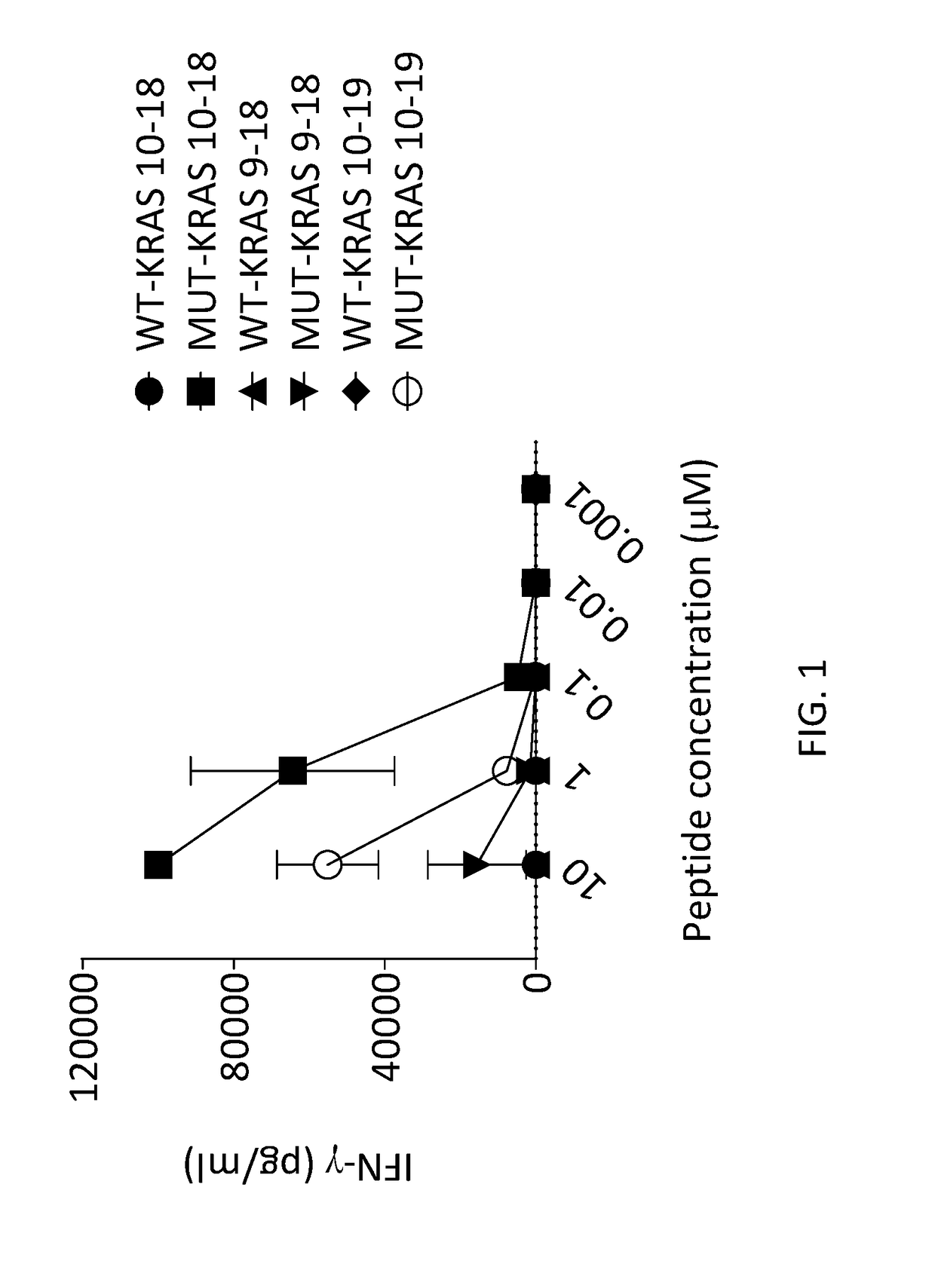T cell receptors recognizing hla-cw8 restricted mutated kras
a technology of t cell receptors and kras, which is applied in the direction of instruments, peptide/protein ingredients, drug compositions, etc., can solve the problems of poor prognosis of many cancers, limited treatment options for cancers, and poor treatment prospects for many cancers,
- Summary
- Abstract
- Description
- Claims
- Application Information
AI Technical Summary
Benefits of technology
Problems solved by technology
Method used
Image
Examples
example 1
[0118]This example demonstrates the identification of somatic mutations present in metastatic tumors.
[0119]Whole-exome or whole-genome sequencing was used to identify somatic mutations present in metastatic tumors derived from 9 patients with cancers originating from the colon, rectum, esophagus, bile ducts, or pancreas (Table 2). The number of mutations ranged from 10 to 155 when using previous methods to call mutations (Table 2) (Tran et al., Science, 344: 641-645 (2014)). However, to evaluate any low coverage and low confidence mutations, the mutation call criteria were relaxed for most samples and thus between 38-264 putative mutations were evaluated (Table 2).
TABLE 2Frequency# TILofRank ofculturesmutation-mutat.-# of# TILwithMutatedAminoTreactivereactivePatientTumor# ofmutationsculturesmutationgeneacidcellTCR inTCR inIDAge / sextypemutations**assessed***assessedreactivity†recognizedchangetypetumor (%)tumor 3737*45 / FBile duct2625 55ERBB2IPE805GCD40.0092718E805GCD40.37510381244 / MBi...
example 2
[0120]This example demonstrates the isolation of T cells that recognize KRAS G12D from a patient with colorectal cancer (Patient No. 3995).
[0121]Multiple TIL cultures were generated from the metastatic lesions of each patient shown in Table 2. To test whether any of the TIL cultures from each patient recognized their own tumor mutations, a tandem minigene (TMG) approach was used as previously described (Lu et al., Clin. Cancer Res., 20: 3401-3410 (2014); Tran et al., Science, 344: 641-645 (2014)). Briefly, these TMGs are comprised of a string of minigenes which are genetic constructs that encode an identified mutation flanked on each side by the 12 wild-type amino acids from the parent protein, except in the case of frameshift mutations where the cDNA was translated until the next stop codon. After in vitro transcription, the TMG RNAs were then individually transfected into autologous antigen presenting cells (APCs), allowing for the potential processing and presentation of all muta...
example 3
[0129]This example demonstrates the isolation of an anti-KRAS G12D TCR from the KRASG12D-specific T cells of Example 2. This example also demonstrates that autologous open-repertoire T cells genetically engineered with the isolated TCR provided HLA-Cw*08:02-restricted recognition of COS-7 cells transfected with KRASG12D.
[0130]The nucleotide sequences encoding the alpha and beta chain variable regions of the TCR of the KRAS G12D-reactive cells isolated in Example 2 were isolated from the T cells. A nucleotide sequence encoding the alpha chain variable region (SEQ ID NO: 9) and beta chain variable region (SEQ ID NO: 10) fused to mouse TCR alpha constant chain (SEQ ID NO: 24) and mouse beta constant chain (SEQ ID NO: 25), respectively, were cloned into an expression vector. Autologous open-repertoire T cells were genetically engineered to express the anti-KRAS G12D TCR.
[0131]The genetically engineered cells were co-cultured with COS-7 cells that were co-transfected with (i) nothing or ...
PUM
| Property | Measurement | Unit |
|---|---|---|
| Volume | aaaaa | aaaaa |
| Fraction | aaaaa | aaaaa |
| Fraction | aaaaa | aaaaa |
Abstract
Description
Claims
Application Information
 Login to View More
Login to View More - R&D
- Intellectual Property
- Life Sciences
- Materials
- Tech Scout
- Unparalleled Data Quality
- Higher Quality Content
- 60% Fewer Hallucinations
Browse by: Latest US Patents, China's latest patents, Technical Efficacy Thesaurus, Application Domain, Technology Topic, Popular Technical Reports.
© 2025 PatSnap. All rights reserved.Legal|Privacy policy|Modern Slavery Act Transparency Statement|Sitemap|About US| Contact US: help@patsnap.com

